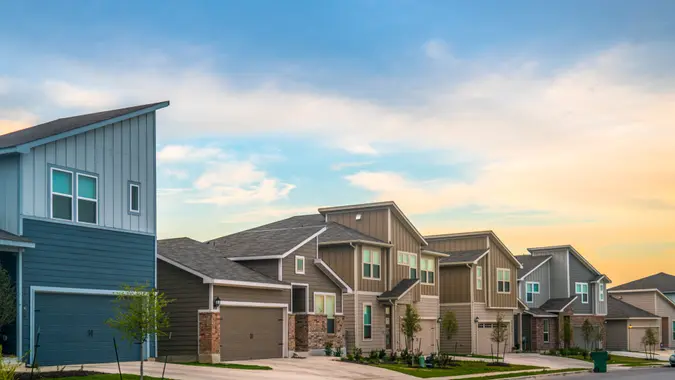Want To Buy a House on a Low Income? Here Are 4 Expert Tips To Get That Property

Commitment to Our Readers
GOBankingRates' editorial team is committed to bringing you unbiased reviews and information. We use data-driven methodologies to evaluate financial products and services - our reviews and ratings are not influenced by advertisers. You can read more about our editorial guidelines and our products and services review methodology.

20 Years
Helping You Live Richer

Reviewed
by Experts

Trusted by
Millions of Readers
Buying a house is an expensive proposition for nearly everyone, but it’s particularly challenging for low-income Americans without a ton of money to spend. The median sales price of a U.S. home is $363,967 as of August 31, 2024, according to Zillow. A recent analysis from Business Insider found that the average monthly mortgage payment is $2,715 on a 30-year fixed mortgage.
To put those numbers in perspective, consider that the median income for full-time workers was $1,143 a week during the 2024 second quarter, according to the U.S. Bureau of Labor Statistics. That equals $59,436 a year or $4,953 a month. Even if you earn the median income, the typical 30-year mortgage would suck up more than half of your monthly earnings. If you have a lower income of $3,500 a month or less, nearly all of it would go to the mortgage alone.
That doesn’t mean you can’t buy a house on a low income. However, getting there requires familiarizing yourself with the market and its requirements, according to Nikki Beauchamp, an associate broker at Sotheby’s International Realty in New York City. Her professional experience includes working as a buyer’s agent and listing agent on Housing Development Fund Corporation (HDFC) cooperative purchases.
“With any property purchase it is important to understand not only the requirements as a buyer, but also what it looks like on an eventual sale and how that impacts timeline and buyer pool,” Beauchamp told GOBankingRates.
If you want to buy a house on a low income, here are four expert tips to help you land your home.
Improve Your Credit Score
One of the biggest factors in qualifying for a home loan is your credit score, and the most common of these is the FICO score. FICO scores can range from 300 (very poor) to 850 (very good), and you’ll need to be closer to the high end to get a loan. A score of 620 or higher is usually required to finance a home purchase. However, some lenders might offer mortgage loans to borrowers with scores as low as 500.
Among the factors that determine whether you qualify for a loan are your debt-to-income (DTI) ratio, loan-to-value ratio (LTV) and income. Here are some tips to improve your credit score and your chances of qualifying for a home loan:
- Review your credit report to ensure everything is accurate.
- Pay bills in full and on time.
- Avoid multiple credit inquiries, which can ding your score.
- Maintain a low credit utilization ratio.
- Keep old credit card accounts open.
Pay Down Debt
According to U.S. Bank, your mortgage payment should be less than 28% of your current gross income, while your total DTI ratio should be 45% or less (including your mortgage payment). If you have a lot of debt tied to credit cards, student loans or other sources, pay these down as soon as possible before trying to buy a house.
This is especially important for people with low incomes because you’ll need to demonstrate that your budget has sufficient room to afford a monthly mortgage payment.
Save for a Down Payment
While you are paying down debt, you should also budget your money so that it includes setting aside funds for a down payment on a new home. The traditional down payment is 20% of the home purchase price, but that’s much less common now than in the past. The median down payment is closer to 15% now, but there are also options for much lower down payments — and even none at all. Even so, the more you can put down, the lower your monthly mortgage payment.
The typical down payment for a first-time homebuyer is about 8% of the home price, according to Rocket Mortgage. Depending on the type of loan you choose and the amount of your down payment, you might have to pay private mortgage insurance (PMI) or a mortgage insurance premium (MIP). These are designed to protect the lender against losses if you fail to pay your mortgage.
Research Government Programs
Numerous programs and grants are available to help low-income and first-time buyers get home loans, and you should investigate these thoroughly.
“One of the very first things I suggest to any buyer is to speak to a lender,” Beauchamp said. “Often the lender will also be able to help with direction on programs that may be available. Some lenders also have special lending opportunities that are based on the census tract where the property is located.”
Some lenders offer special rates and discounts to help low-income customers obtain home loans. In terms of government-backed loan programs, here are some of the options for low-income buyers:
- United States Department of Agriculture (USDA) loans: This is a good option for buyers with low-to-moderate incomes in rural areas. These are zero-down payment loans with low interest rates and typically have more flexible credit requirements than conventional loans.
- Federal Housing Administration (FHA) loans: These are government-backed loans that typically have lower credit requirements than conventional fixed-rate loans and adjustable-rate mortgages. The minimum down payment is only 3.5% and the loans are available to all qualified buyers, regardless of income.
- Veterans Affairs (VA) loans: VA loans are available to active U.S. service members, veterans and eligible surviving spouses and let you buy a home with little or no down payment. Even with no down payment, VA loans don’t require mortgage insurance because the VA guarantees a portion of your loan.
More From GOBankingRates
 Written by
Written by  Edited by
Edited by 

























